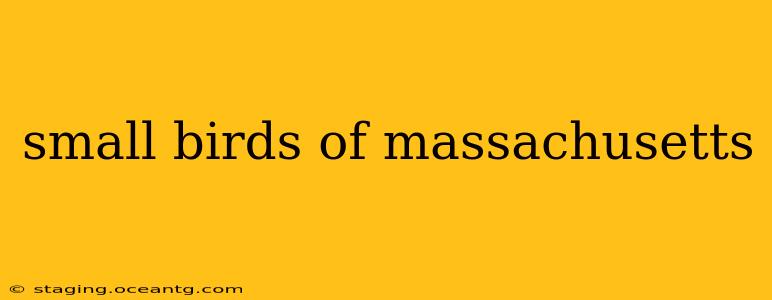Massachusetts boasts a vibrant avian population, with numerous small bird species calling the state home year-round or visiting during migration. Identifying these tiny feathered friends can be a rewarding pastime, enriching your understanding of the natural world. This guide explores some of the most common small birds found in Massachusetts, offering insights into their identification, habitat preferences, and behaviors.
What are some of the smallest birds in Massachusetts?
Several tiny birds grace the Massachusetts landscape. Among the smallest are the Goldcrest, a tiny acrobatic bird often overlooked due to its size; the Ruby-crowned Kinglet, known for its surprisingly loud song; and the House Wren, a common backyard visitor with a bustling energy. While precise measurements vary slightly depending on the individual and subspecies, these consistently rank among the smallest. Remember that size can be deceptive, and distinguishing them often relies on plumage and behavior as much as sheer size.
What are the common small birds found in Massachusetts backyards?
Many small bird species frequent Massachusetts backyards, attracted by readily available food sources and suitable nesting sites. Common backyard visitors include:
- Chickadees: These tiny, fluffy birds are easily identified by their black caps, white cheeks, and cheerful calls. They are incredibly resilient and adaptable.
- Tufted Titmice: Similar in size to chickadees, tufted titmice possess a prominent crest and a grayish-brown plumage. They are often seen gleaning insects from branches.
- Downy Woodpeckers: While technically woodpeckers, these small species are frequently spotted in backyard trees, pecking at insects and seeds. Their distinctive black and white patterning makes them easy to identify.
- House Wrens: These energetic birds are known for their loud, bubbling songs and their habit of nesting in almost any available cavity.
- American Robins: While not strictly "small," they are frequently observed in backyards, especially during breeding season, and are a familiar sight to many.
Offering a variety of bird feeders with different types of seeds, suet, and nuts will help attract a wide range of small birds to your backyard. Providing fresh water is crucial, especially during hot summer months.
What small birds migrate through Massachusetts?
Massachusetts's location on a major migratory flyway means countless small birds pass through during spring and autumn. Some notable migrants include:
- Warblers: A vast array of warbler species, often brilliantly colored, traverse the state during their northward and southward journeys. Identification can be challenging due to their similar sizes and subtle plumage variations.
- Flycatchers: These aerial insectivores are adept at catching insects mid-flight. They often perch conspicuously on branches, waiting for their prey.
- Hummingbirds: Though tiny, these dazzling birds are unmistakable. Ruby-throated Hummingbirds are common migrants to Massachusetts.
How can I identify small birds in Massachusetts?
Identifying small birds requires patience and keen observation. Useful tools include:
- Field guides: A good field guide with detailed illustrations and descriptions is essential.
- Binoculars: These will significantly aid in viewing the fine details of plumage and behavior.
- Bird identification apps: Several apps use image recognition to help identify birds.
- Learning bird songs and calls: Bird vocalizations are key to identification, even when the bird is hidden in foliage.
Remember that practice makes perfect. The more you observe birds in their natural environment, the better you will become at distinguishing the subtle differences between species.
What are the best places to birdwatch for small birds in Massachusetts?
Massachusetts offers a wealth of excellent birdwatching locations. Many state parks, wildlife sanctuaries, and coastal areas provide diverse habitats suitable for small birds. Researching specific locations known for particular species will increase your chances of successful birdwatching outings. Remember to respect wildlife and their habitats while enjoying the experience.
By combining careful observation, the use of appropriate tools, and a bit of patience, anyone can appreciate the diversity and beauty of the small birds that call Massachusetts home. Happy birding!
